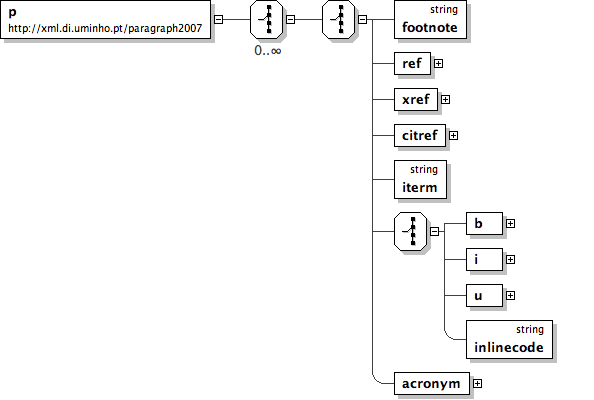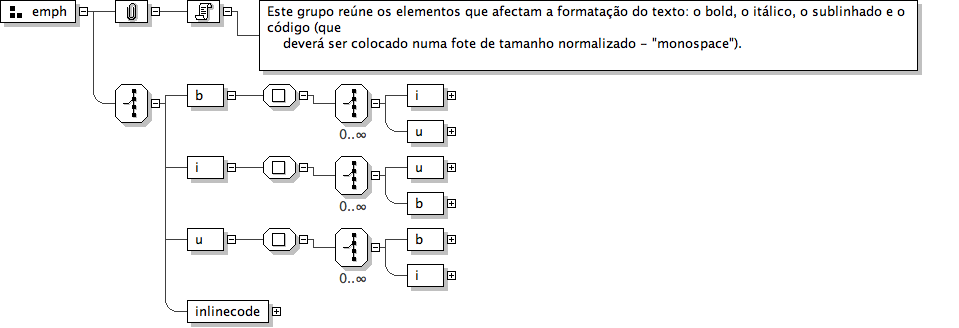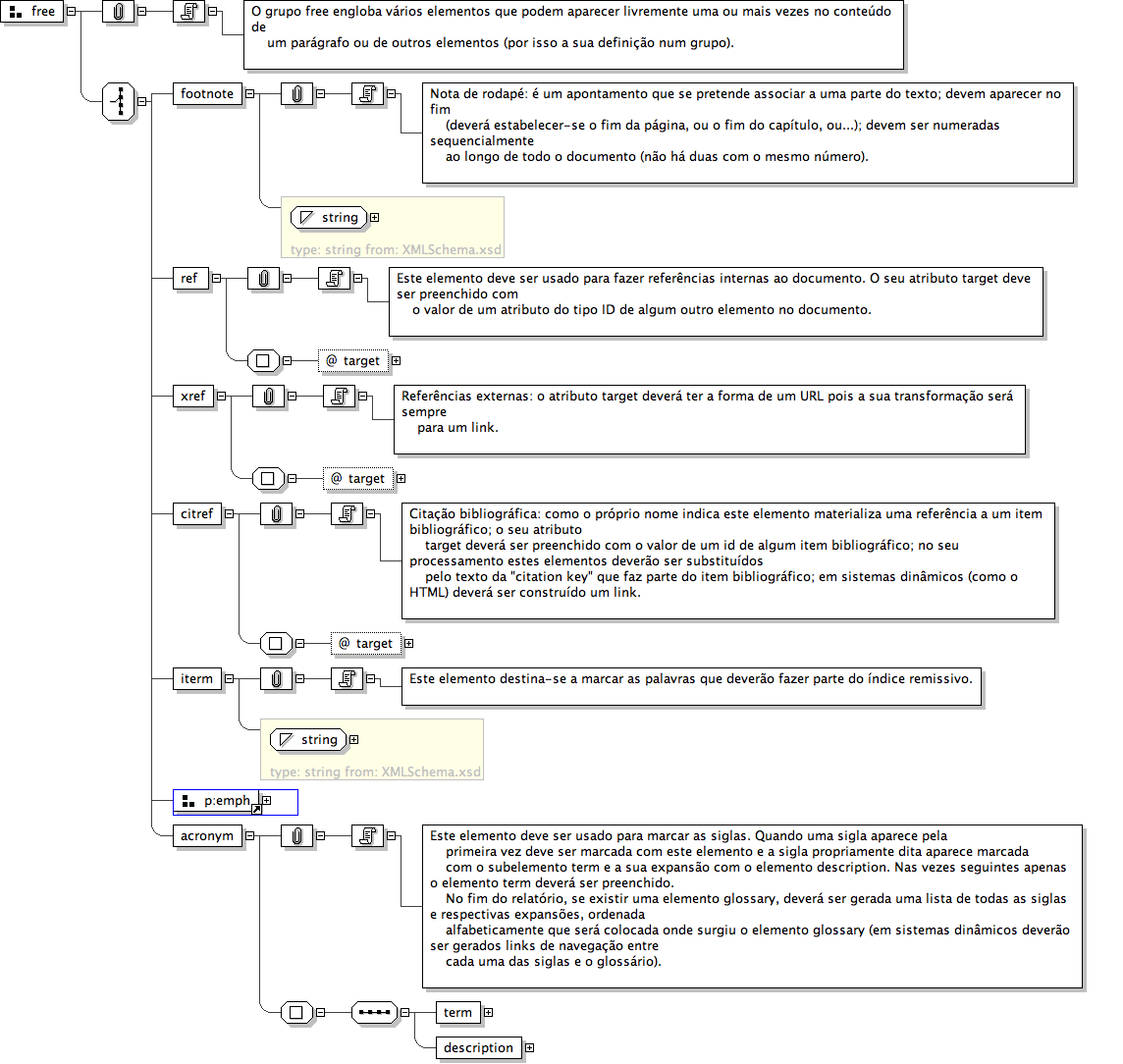
| Target Namespace | http://xml.di.uminho.pt/paragraph2007 |
|---|---|
| Element and Attribute Namespaces |
|
| Prefix | Namespace |
|---|---|
| p | http://xml.di.uminho.pt/paragraph2007 |
| xml | http://www.w3.org/XML/1998/namespace |
| xs | http://www.w3.org/2001/XMLSchema |
| report | http://xml.di.uminho.pt/report2007 |
| Name | p |
|---|---|
| Type | Locally-defined complex type |
| Nillable | no |
| Abstract | no |
| Documentation | Este é o elemento principal do parágrafo. Foi decidido criar um Schema próprio para o elemento parágrafo para o poder reutilizar em várias aplicações. |

'Nota de rodapé: é um apontamento que se pretende associar a uma parte do texto; devem aparecer no fim (deverá estabelecer-se o fim da página, ou o fim do capítulo, ou...); devem ser numeradas sequencialmente ao longo de todo o documento (não há duas com o mesmo número).'
'Este elemento deve ser usado para fazer referências internas ao documento. O seu atributo target deve ser preenchido com o valor de um atributo do tipo ID de algum outro elemento no documento.'
'Referências externas: o atributo target deverá ter a forma de um URL pois a sua transformação será sempre para um link.'
'Citação bibliográfica: como o próprio nome indica este elemento materializa uma referência a um item bibliográfico; o seu atributo target deverá ser preenchido com o valor de um id de algum item bibliográfico; no seu processamento estes elementos deverão ser substituídos pelo texto da \"citation key\" que faz parte do item bibliográfico; em sistemas dinâmicos (como o HTML) deverá ser construído um link.'
'Este elemento destina-se a marcar as palavras que deverão fazer parte do índice remissivo.'
'Este elemento deve ser usado para marcar as siglas. Quando uma sigla aparece pela primeira vez deve ser marcada com este elemento e a sigla propriamente dita aparece marcada com o subelemento term e a sua expansão com o elemento description. Nas vezes seguintes apenas o elemento term deverá ser preenchido. No fim do relatório, se existir uma elemento glossary, deverá ser gerada uma lista de todas as siglas e respectivas expansões, ordenada alfabeticamente que será colocada onde surgiu o elemento glossary (em sistemas dinâmicos deverão ser gerados links de navegação entre cada uma das siglas e o glossário).'

| Name | emph |
|---|---|
| Used by (from the same schema document) | Model Group free |
| Documentation | Este grupo reúne os elementos que afectam a formatação do texto: o bold, o itálico, o sublinhado e o código (que deverá ser colocado numa fote de tamanho normalizado - "monospace"). |

| Name | free |
|---|---|
| Used by (from the same schema document) | Element p |
| Documentation | O grupo free engloba vários elementos que podem aparecer livremente uma ou mais vezes no conteúdo de um parágrafo ou de outros elementos (por isso a sua definição num grupo). |
'Nota de rodapé: é um apontamento que se pretende associar a uma parte do texto; devem aparecer no fim (deverá estabelecer-se o fim da página, ou o fim do capítulo, ou...); devem ser numeradas sequencialmente ao longo de todo o documento (não há duas com o mesmo número).'
'Este elemento deve ser usado para fazer referências internas ao documento. O seu atributo target deve ser preenchido com o valor de um atributo do tipo ID de algum outro elemento no documento.'
'Referências externas: o atributo target deverá ter a forma de um URL pois a sua transformação será sempre para um link.'
'Citação bibliográfica: como o próprio nome indica este elemento materializa uma referência a um item bibliográfico; o seu atributo target deverá ser preenchido com o valor de um id de algum item bibliográfico; no seu processamento estes elementos deverão ser substituídos pelo texto da \"citation key\" que faz parte do item bibliográfico; em sistemas dinâmicos (como o HTML) deverá ser construído um link.'
'Este elemento destina-se a marcar as palavras que deverão fazer parte do índice remissivo.'
'Este elemento deve ser usado para marcar as siglas. Quando uma sigla aparece pela primeira vez deve ser marcada com este elemento e a sigla propriamente dita aparece marcada com o subelemento term e a sua expansão com o elemento description. Nas vezes seguintes apenas o elemento term deverá ser preenchido. No fim do relatório, se existir uma elemento glossary, deverá ser gerada uma lista de todas as siglas e respectivas expansões, ordenada alfabeticamente que será colocada onde surgiu o elemento glossary (em sistemas dinâmicos deverão ser gerados links de navegação entre cada uma das siglas e o glossário).'

| Super-types: | Address < AusAddress (by extension) |
|---|---|
| Sub-types: |
|
| Name | AusAddress |
|---|---|
| Abstract | no |
The XML Instance Representation table above shows the schema component's content as an XML instance.
Abstract (Applies to complex type definitions and element declarations). An abstract element or complex type cannot used to validate an element instance. If there is a reference to an abstract element, only element declarations that can substitute the abstract element can be used to validate the instance. For references to abstract type definitions, only derived types can be used.
All Model Group Child elements can be provided in any order in instances. See: http://www.w3.org/TR/xmlschema-1/#element-all.
Choice Model Group Only one from the list of child elements and model groups can be provided in instances. See: http://www.w3.org/TR/xmlschema-1/#element-choice.
Collapse Whitespace Policy Replace tab, line feed, and carriage return characters with space character (Unicode character 32). Then, collapse contiguous sequences of space characters into single space character, and remove leading and trailing space characters.
Disallowed Substitutions
(Applies to element declarations). If substitution is specified, then substitution group members cannot be used in place of the given element declaration to validate element instances. If derivation methods, e.g. extension, restriction, are specified, then the given element declaration will not validate element instances that have types derived from the element declaration's type using the specified derivation methods. Normally, element instances can override their declaration's type by specifying an xsi:type attribute.
Key Constraint Like Uniqueness Constraint, but additionally requires that the specified value(s) must be provided. See: http://www.w3.org/TR/xmlschema-1/#cIdentity-constraint_Definitions.
Key Reference Constraint Ensures that the specified value(s) must match value(s) from a Key Constraint or Uniqueness Constraint. See: http://www.w3.org/TR/xmlschema-1/#cIdentity-constraint_Definitions.
Model Group Groups together element content, specifying the order in which the element content can occur and the number of times the group of element content may be repeated. See: http://www.w3.org/TR/xmlschema-1/#Model_Groups.
Nillable
(Applies to element declarations). If an element declaration is nillable, instances can use the xsi:nil attribute. The xsi:nil attribute is the boolean attribute, nil, from the http://www.w3.org/2001/XMLSchema-instance namespace. If an element instance has an xsi:nil attribute set to true, it can be left empty, even though its element declaration may have required content.
Notation A notation is used to identify the format of a piece of data. Values of elements and attributes that are of type, NOTATION, must come from the names of declared notations. See: http://www.w3.org/TR/xmlschema-1/#cNotation_Declarations.
Preserve Whitespace Policy Preserve whitespaces exactly as they appear in instances.
Prohibited Derivations (Applies to type definitions). Derivation methods that cannot be used to create sub-types from a given type definition.
Prohibited Substitutions (Applies to complex type definitions). Prevents sub-types that have been derived using the specified derivation methods from validating element instances in place of the given type definition.
Replace Whitespace Policy Replace tab, line feed, and carriage return characters with space character (Unicode character 32).
Sequence Model Group Child elements and model groups must be provided in the specified order in instances. See: http://www.w3.org/TR/xmlschema-1/#element-sequence.
Substitution Group Elements that are members of a substitution group can be used wherever the head element of the substitution group is referenced.
Substitution Group Exclusions (Applies to element declarations). Prohibits element declarations from nominating themselves as being able to substitute a given element declaration, if they have types that are derived from the original element's type using the specified derivation methods.
Target Namespace The target namespace identifies the namespace that components in this schema belongs to. If no target namespace is provided, then the schema components do not belong to any namespace.
Uniqueness Constraint Ensures uniqueness of an element/attribute value, or a combination of values, within a specified scope. See: http://www.w3.org/TR/xmlschema-1/#cIdentity-constraint_Definitions.